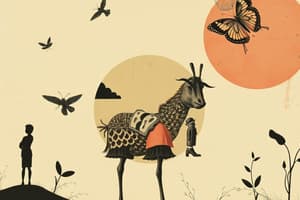Podcast
Questions and Answers
What is primarily measured to determine reproductive success in animals?
What is primarily measured to determine reproductive success in animals?
- The strength of parental care provided
- The number of offspring produced and their survival rate (correct)
- The amount of resources consumed during gestation
- The size of the reproductive organs
Which of the following components is typically part of a male reproductive system?
Which of the following components is typically part of a male reproductive system?
- Uterus
- Urethra (correct)
- Oviducts
- Ovaries
What role do hormones play in reproductive systems?
What role do hormones play in reproductive systems?
- They produce gametes directly.
- They eliminate parasites during reproduction.
- They only affect fetal development.
- They regulate the development and function of reproductive systems. (correct)
Which reproductive technology involves fertilizing eggs and sperm outside the body?
Which reproductive technology involves fertilizing eggs and sperm outside the body?
Which environmental factor does NOT typically influence reproductive success?
Which environmental factor does NOT typically influence reproductive success?
What defines asexual reproduction?
What defines asexual reproduction?
Which method of asexual reproduction involves a single organism dividing into two?
Which method of asexual reproduction involves a single organism dividing into two?
What is the primary advantage of asexual reproduction?
What is the primary advantage of asexual reproduction?
Which of the following correctly describes meiosis?
Which of the following correctly describes meiosis?
What is an advantage of sexual reproduction?
What is an advantage of sexual reproduction?
Which of the following describes external fertilization?
Which of the following describes external fertilization?
Which reproductive strategy might be employed by hydra?
Which reproductive strategy might be employed by hydra?
What is a key disadvantage of asexual reproduction?
What is a key disadvantage of asexual reproduction?
Flashcards
Reproductive Success
Reproductive Success
The measure of an organism's ability to produce offspring who survive and reproduce.
Animal Reproductive Systems
Animal Reproductive Systems
Specialized systems in animals for producing and delivering gametes.
In-Vitro Fertilization (IVF)
In-Vitro Fertilization (IVF)
Fertilizing eggs and sperm outside the body.
Environmental Factors Impacting Reproduction
Environmental Factors Impacting Reproduction
Signup and view all the flashcards
Seasonal Breeding
Seasonal Breeding
Signup and view all the flashcards
Asexual Reproduction
Asexual Reproduction
Signup and view all the flashcards
Binary Fission
Binary Fission
Signup and view all the flashcards
Sexual Reproduction
Sexual Reproduction
Signup and view all the flashcards
Gametes
Gametes
Signup and view all the flashcards
Meiosis
Meiosis
Signup and view all the flashcards
Fertilization
Fertilization
Signup and view all the flashcards
Genetic Variation
Genetic Variation
Signup and view all the flashcards
Vegetative Propagation
Vegetative Propagation
Signup and view all the flashcards
Study Notes
Asexual Reproduction
- Asexual reproduction involves a single organism producing offspring identical to itself.
- This process does not involve the fusion of gametes (sex cells).
- Common methods include binary fission, budding, fragmentation, and vegetative propagation.
- Binary fission: A single organism divides into two identical organisms. This is common in prokaryotes like bacteria.
- Budding: A new organism develops from an outgrowth or bud on the parent organism, often seen in yeasts and some invertebrates.
- Fragmentation: A parent organism breaks into fragments, each of which can develop into a new organism. This is common in some worms and starfish.
- Vegetative propagation: A new plant develops from vegetative parts of the parent plant, such as stems, roots, or leaves. This is common in many plants.
- Advantages of asexual reproduction: Rapid production of identical offspring. It requires only one parent.
- Disadvantages of asexual reproduction: Lack of genetic variation. Offspring are vulnerable to the same environmental threats as the parent.
Sexual Reproduction
- Sexual reproduction involves the fusion of male and female gametes.
- This results in offspring with a combination of genetic material from both parents.
- This increases genetic diversity, which is crucial to the survival of a species in varying environments.
- Gametes: Specialized reproductive cells that contain half the number of chromosomes of a normal cell.
- Meiosis: The process of cell division which reduces the chromosome number by half. This occurs during the production of gametes.
- Fertilization: The fusion of the male and female gametes to form a zygote.
- External fertilization: Occurs outside the body of the organism, often in aquatic environments.
- Internal fertilization: Occurs inside the body of the organism.
- Advantages of sexual reproduction: Genetic variation. Greater adaptability to changing environments.
- Disadvantages of sexual reproduction: Slower reproduction rate. Requires two parents.
Reproductive Strategies in Different Organisms
- Organisms employ various strategies for reproduction based on their environment and survival needs.
- Many plants utilize both asexual and sexual reproduction to ensure their survival.
- Some organisms, like hydra, demonstrate both strategies.
- Environmental conditions can influence the type of reproduction in an organism.
- Reproductive success is measured by the number of offspring produced and their ability to survive and reproduce themselves.
Reproductive Systems in Animals
- Animals have specialized reproductive systems that support the production of gametes and the process of reproduction.
- Female reproductive systems typically involve ovaries, oviducts, uterus, and vagina.
- Male reproductive systems typically involve testes, epididymis, vas deferens, and urethra.
- Hormones regulate the development and function of reproductive systems.
- The menstrual cycle in mammals is a complex process involving hormonal fluctuations that prepares the body for potential pregnancy.
- The process of childbirth involves the coordinated action of multiple systems in the mother's body.
Reproductive Technologies
- In-vitro fertilization (IVF): A technique where eggs and sperm are fertilized outside the body.
- Artificial insemination: Involves introducing sperm into the reproductive tract of the female, bypassing natural mating.
- Cloning: Producing genetically identical copies of an organism, either naturally or artificially. This can be through somatic cell nuclear transfer.
Factors Affecting Reproduction
- Environmental factors (e.g., temperature, light, availability of resources) play a crucial role in reproduction.
- Some organisms exhibit seasonal breeding cycles, tied to environmental cues.
- Competition for resources can impact reproductive success.
- Parasites and diseases can also exert significant negative influences.
Studying That Suits You
Use AI to generate personalized quizzes and flashcards to suit your learning preferences.




